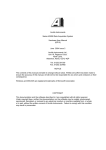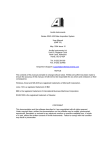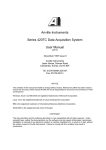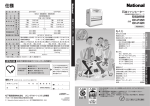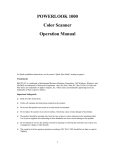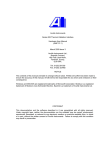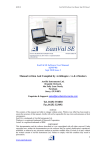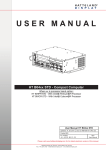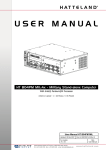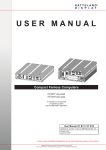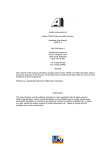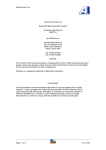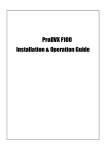Download Series 415TC handbook
Transcript
Anville Instruments Series 415 Data Acquisition System Hardware User Manual (QMF 37-3) March 2002 Issue 1 Anville Instruments Ltd Unit 19, Pegasus Court North Lane Aldershot, Hants GU12 4QP Tel. 01252 351030 Fax. 01252 323429 NOTICE The contents of this manual are liable to change without notice. Whilst every effort has been made to ensure the accuracy of this manual, Anville will not be responsible for any errors and omissions or their consequence. Windows and MS-DOS are registered trademarks of Microsoft Corporation. COPYRIGHT This documentation and the software described in it are copyrighted with all rights reserved. Under copyright laws, neither the documentation nor the software may be copied, photocopied, reproduced, translated, or reduced to any electronic medium or machine readable form, in whole or in part, without the written consent of Anville Instruments. Failure to comply with this condition may result in prosecution. QMF 37-1 S415 Hardware User Manual. June 2004. Iss. 2 CONTENTS PART I: INTRODUCTION TO THE SERIES 415 PART II: SERIES 415 CONFIGURATION PART III: CONNECTING THE SERIES 415 TO YOUR COMPUTER PART IV: SPECIFICATIONS Page 2 of 17 QMF 37-1 S415 Hardware User Manual. June 2004. Iss. 2 AN OVERVIEW OF THIS USER MANUAL This manual is divided into 4 parts. Part I introduces you to the SERIES 415. Starting with Part II, the manual shows you how to configure and operate the unit. After mastering the system, you can use the manual as a handy reference. When you need help with a specific problem, turn to the appropriate area of the manual that describes that part of the system. To give you an idea of the manual’s layout, here is a description of each part of the manual: • Part I describes the hardware for both the SERIES 415 and the computer system. • Part II describes system hardware configuration and tells you how to connect the different types of sensors. • Part III tells you how to connect the SERIES 415 unit to your computer. • Part IV provides specifications for the SERIES 415 equipment. Page 3 of 17 QMF 37-1 S415 Hardware User Manual. June 2004. Iss. 2 PART I: INTRODUCTION TO SERIES 415 OVERVIEW Welcome to the SERIES 415 Data Acquisition Units which provide a combination of 8 thermocouple and general purpose analogue inputs. The units operate in conjunction with a wide variety of bespoke or SCADA computer based software packages. The SERIES 415 is connected to a compatible computer system which provides the SCADA software operating environment working under Windows 3.x, Windows for Work Groups, Win’95/98 and Windows NT. The compact hardware provides thermocouple and general purpose analogue inputs, 8 digital inputs, 8 digital outputs and frequency input. Connection to a computer, using the supplied cable, is made via an RS422/423 serial link. An additional RS422/423 connector allows you to ‘daisy-chain’ two SERIES 415s together if more analogue inputs are needed. The SERIES 415’s internal microprocessor converts all inputs into their correct engineering units for transmission to the host computer. Unit Versions SERIES 415-4 provides 6 thermocouple and 2 general purpose inputs. SERIES 415-6 provides 4 thermocouple and 4 general purpose inputs. COMPATIBLE COMPUTER SYSTEM Any currently available computer having a Pentium or similar processor. The computer, whether a desktop or portable model should contain CD and floppy disk drives, printer port and a COM port (9-pin D type connector). The COM port is used to connect the data logger to the computer. Some computers have a USB connector fitted instead of the 9-pin D connector. In this case a USB package, comprising a cable and USB driver software CD must be acquired. Please consult your IT department for help to configure your computer to enable the USB port. The USB cable is then used to connect the data logger and computer together. Page 4 of 17 QMF 37-1 S415 Hardware User Manual. June 2004. Iss. 2 PART II: SERIES 415 CONFIGURATION Box Address Your SERIES 415 is supplied with its’ address set to zero. An address is set by the positions of switches 1 to 4 of the UNIT CONFIGURATION switch array. See SERIES 415 side panel. If more than one SERIES 415 is to be used on the computer port, it will be necessary to alter switch settings of any additional SERIES 415s thus providing each one with a unique address. For example, box 1 will have address 0, box 2 address 1 and so on. To initialise switch settings, power to the SERIES 415 must be turned off then on. The table below provides configuration address and switch settings. Switch setting 1 2 3 4 on on on on off on on on on off on on off off on on on on off on off on off on on off off on off off off on on on on off off on on off on off on off off off on off on on off off off on off off on off off off off off off off Unit address 0 1 2 3 4 5 6 7 8 9 10 11 12 13 14 15 Unit Configuration Table Communication Baud Rate Your SERIES 415 is supplied with baud rate set to 9600. If you need to change the baud rate, use switches 5 and 6 of the UNIT CONFIGURATION switch array. The following table gives switch settings for specific baud rates. To initialise switch settings, power to the SERIES 415 must be turned off then on. Please note that whichever baud you configure, you must also set the same baud in Windows Control Panel to match. See below how to do this. Switch settings 5 6 on on off on on off off off Baud rate 1200 2400 9600 19200 Communication Format The communication format is fixed and will consist of 8 data bits, 1 stop bit, no parity, flow control- none. Please note that if you are not using the software supplied it is very important that you set the communication format and baud rate for the chosen serial port using WINDOWS Start, Settings, Control Panel before operating the SERIES 415. Page 5 of 17 QMF 37-1 S415 Hardware User Manual. June 2004. Iss. 2 Analogue Outputs (option) Two analogue outputs may be factory fitted to the SERIES 415. Configuration details are shown below with connections being made via a 4- pin plug in terminal block. Pin no. 1 3 Signal name anout ground anout ground Pin no. 2 4 Signal name anout 2 anout1 Frequency Input The Series 415 provides inputs for measuring both pulse count and frequency (Hz). The type of input configuration is dependent on the type of signal output from equipment connected to the logger. Selection of counter or frequency is made during software configuration. Connections to the logger are made via a 4-way screw block plug. The table and diagrams below show pin and input connections. Pin No. 1 3 Signal Name +5V output trig. level Pin No. 2 4 Signal Name input ground A logic level/uni-polar input with a signal level of between 0V to 5V (CMOS/TTL) would (generally) use the connections shown in the Logic Level Input Circuit diagram. 0V to 2.4V ±100mV = logic 0; 2.6 ±100mV to 5V = logic 1. Pulse count input has a range of 0 to 65535 counts. Counts are not cumulative; each ‘new’ count will replace the previous count. Logic Level Input Circuit An AC signal/bi-polar input, from 0 to 65Khz, would (generally) be measured using the Zero Crossing Level circuit connections with voltage levels from 100mV peak-to-peak to 10V peak-to-peak. Voltage levels below 100mV will not be ‘seen’ by the logger. Zero Crossing Level Circuit The +5VDC on pin 1 can be used to power devices where the current requirement is not more than 5mA. Digital Inputs (digin) The SERIES 415 provides 8 optically isolated digital inputs. With reference to the table below, digin signals on pins 2-5 are measured with respect to pin 1 and digin signals on pins 5-8 are measured with respect to pin 6. Page 6 of 17 QMF 37-1 S415 Hardware User Manual. June 2004. Iss. 2 Pin 1 2 3 4 5 Signal name ground digin 1 digin 2 digin 3 digin 4 Pin 6 7 8 9 10 Signal name ground digin 5 digin 6 digin 7 digin 8 The input connector provides access to one end of the LED of an optical isolator with a 4K7 Series resister to limit current. Connections are via a 10-pin plug supplied with the unit. A typical digital input circuit Digital Outputs (Digout) The SERIES 415 provides 8 digital outputs. These are open collector transistor type outputs capable of directly driving relays. With reference to the table below, digout on pins 2-5 are with respect to pin 1 and digout on pins 5-8 are with respect to pin 6. Connections are via a 10- pin plug supplied with the unit. Pin no. 1 2 3 4 5 Signal name ground digout 1 digout 2 digout 3 digout 4 Pin no. 6 7 8 9 10 Signal name ground digout 5 digout 6 digout 7 digout 8 A typical digital output circuit Page 7 of 17 QMF 37-1 S415 Hardware User Manual. June 2004. Iss. 2 PART III: CONNECTING THE SERIES 415 TO YOUR COMPUTER IMPORTANT NOTE: please refer to PART IV: SPECIFICATIONS if you do not intend using the cable supplied. NOTE: Pins 6 and 8, pins 7 and 8 of the ‘D’ type plug are no longer linked for RS232 or RS422 operation. Units are factory set for the required protocol. However, cables with links fitted can still be used. Pin configuration details are retained for reference. The SERIES 415 is supplied with a 2 metre length cable (which meets the requirements of RS232) fitted with 9 pin 'D' type plug and socket. The system requires transmit (Tx), receive (Rx) and ground connections for most applications, so these are the only signal connections made in both plug and socket. Pins 6 and 8 or pins 7 and 8 are linked depending on serial data transmission protocol. Links are made in the cable plug end that is connected to the logger. Cable wiring details are given below. Pin 2 3 5 6 7 8 Pins 1,4 and 9 are not used. Signal name Tx Rx signal ground RS422 link RS423 link +5V Signal direction to Computer from Computer Wire white black screen Linked to pin 8 Linked to pin 8 The SERIES 415 has two serial port connectors, SERIAL IN and SERIAL OUT. As a general rule, SERIAL OUT will be connected to your computer in a single unit installation. Where a second unit is used, it will be connected into the system by 'daisy chaining' the SERIAL IN to the SERIAL OUT of the first unit. Cable connections for ‘daisy chaining’ a SERIES 415 are given in the table below. Pin 2 3 5 6 7 8 Signal name Tx Rx Signal ground RS422link RS423 link +5V Signal direction to next 415 from next 415 Wire white black screen Linked to pin 8 Linked to pin 8 RS422 Transmission If the overall line length (distance) between your PC and the second daisy-chained logger exceeds 30 metres (approx. 65 feet) an RS422 serial card must be fitted to your PC to maintain signal integrity. RS422 signal titles and pin connections are given in the table below. In addition the serial cable link between pins 7and 8 must be removed and pins 6 and 8 linked. See previous table. Pin 1 2 3 4 5 Signal Name Txb Txa Rxa Rxb ground Signal Direction to computer to computer from computer from computer Page 8 of 17 QMF 37-1 S415 Hardware User Manual. June 2004. Iss. 2 Power Up Note: in order to comply with European EMC legislation the Series 415 must be connected to mains earth. No action is necessary if the supplied mains adapter is used. The SERIES 415 is dc powered requiring +5V at 0.5A and +24V at 0.2A. The unit is normally supplied with a 230V AC mains adapter which will provide correct input voltages. Power enters the SERIES 415 via the 4 pin connector on the rear panel. Where several units are to be mounted within an enclosure it may be beneficial to power them from a Common supply. Power connection details are: Pin 1 2 3 4 Signal name Earth 0V +5V +24V Front Panel Connection Details Thermocouple connections are made using miniature plugs and general purpose connections (other analogue inputs) are made through 9-pin D type plugs supplied with the SERIES 415. Please note that connections to D type plugs must be soldered. Pin numbers shown are viewed through the plug from the solder connector side. Thermocouple Inputs CAUTION Where thermocouples are used involving fluids or condensing gases, for example with Autoclaves, they must be connected to the data logger in one of two ways: 1. At a point lower than the logger, remove at least 2.5cm of insulating material from the thermocouple wire. 2. Make thermocouple connections to the logger via flying leads, either below logger level or at a distance of 0.5 metres, with an in-line cable mounting socket attached. Both of these methods ensure that any liquids migrating up the thermocouple wire due to the capillary effect, escape before reaching the logger. Serious damage to the logger will result if liquid is allowed to enter. Page 9 of 17 QMF 37-1 S415 Hardware User Manual. June 2004. Iss. 2 General Purpose Analogue Inputs On all input connectors, +24V dc is available across pins 5 and 9. This voltage is for use with instruments such as transducers that are unable to respond quickly enough to a pulsed excitation voltage (ref. Fig.4) and as a result require a permanent supply voltage. Maximum current is 50mA. Figure1: 24Vdc output connections. Current 50mA max. Figure 2 Voltage input Figure 3. Current loop input: 4 to 20mA (powered by transmitter or other source e.g.Fig.1) Figure 4. Current loop input: 4 to 20mA (powered by Series 415 using pulsed voltage output) Page 10 of 17 QMF 37-1 S415 Hardware User Manual. June 2004. Iss. 2 Figure 5. Thermocouple input Note: do not fit link between pins 3 and 7 if using grounded thermocouples Figure 6. Pt100 or resistive inputs Figure 7. Transducer input Page 11 of 17 QMF 37-1 S415 Hardware User Manual. June 2004. Iss. 2 Transducer Connections - 4-20mA output. Please note that this wiring diagram is an alternative to Figure 4 and should be used if a transducer, connected as Figure 4 does not respond. The example shows how you would connect a 2-wire transducer to the unit (Fig.3) using the +24V available from the connector as an excitation voltage. Page 12 of 17 QMF 37-1 S415 Hardware User Manual. June 2004. Iss. 2 PART IV: SPECIFICATIONS DATA LOGGER Construction The SERIES 415 data logger is constructed as a metal box formed by 2 U-shaped sections. A bottom box section forms the mount for printed circuit boards (PCB). All components are mounted on the PCBs. A top box section locates over the bottom section, allowing access to connectors and switches and is secured into position using 4 M3x6mm screws. Four rubber feet are screwed to the bottom. Dimensions: 269mm long, 150mm wide, 95mm deep (including feet). Connectors • • • • • • • 8 inputs (combinations of thermocouple and general purpose connectors). 2 RS423 ports 1 digital input 1 digital output 1 analogue output (option) 1 power input 1 frequency input Switches • 4 unit configuration • 2 baud rate Mounting and Ventilation To mount a logger, remove rubber feet and use the same screw locations. Maximum screw length penetration is M3x4mm. It is dangerous to exceed the recommended penetration length as damage to internal components could occur. The logger requires no special ventilation requirements. Cleaning Loggers are easy to clean. Use a non-abrasive or foam cleaner. ANALOGUE INPUTS Direct Voltage and Current Range ±10mV ±100 mV ± 1V ± 10v 4-20mA Resolution 1uV 10 uV 100 uV 1 mV 0.01% Page 13 of 17 Accuracy ±0.02% ±0.02% ±0.02% ±0.02% ±0.02% QMF 37-1 S415 Hardware User Manual. June 2004. Iss. 2 Thermocouples Input range °C -200 to +400 -100 to +200 -200 to +1200 -100 to +200 -100 to +1100 0 to +1300 -100 to +1000 0 to +1700 0 to +1700 0 to +1800 Input function T thermocouple T thermocouple K thermocouple K thermocouple J thermocouple N thermocouple E thermocouple R thermocouple S thermocouple B thermocouple Resolution °C 0.1 0.01 0.1 0.01 0.1 0.1 0.1 1 1 1 Accuracy °C* ± 0.5 ± 0.25 ± 0.5 ± 0.5 ± 0.5 ± 0.5 ± 0.5 ±4 ±4 ±4 * Note: accuracy includes cold junction error when using thermocouple sockets but not when using general purpose sockets. PT100 - 100 ohms @ 0°C, 4 wire connection Range °C -100 to +600 -100 to +200 Resolution °C 0.1 0.01 Accuracy °C +/-0.5 +/-0.2 Pressure transducer/load cell Range ±10 mV ±100 mV ±1V ±10 V Resolution 1 uV 10 uV 100 uV 1 mV Accuracy ±0.02% ±0.02% ±0.02% ±0.02% Signal conditioning For thermocouple, PT100 and pressure transducers. Transducer energisation • For PT100: switched constant current of 1mA. • For pressure transducer/load cell: switched constant voltage of 10V. • For 4-20mA current loop: switched constant voltage of 24V. Input switching Reed relay - 3 pole switching. Engineering units As appropriate or selectable: mV, V, mA, C, % ( as appropriate or selected). Scan speed 8-16 inputs per seconds Configuration using X-415 software. Serial link Page 14 of 17 QMF 37-1 S415 Hardware User Manual. June 2004. Iss. 2 RS232 or RS422. Choice dependant on cable length. Cable length Maximum cable length for RS232 operation is approximately 30 metres. Maximum cable length for RS422 operation is approximately 1.5 kilometres. To avoid electrical interference the serial cable should be installed away from other cables particularly mains voltage cables. Ideally the serial link should be installed in it’s own trunking Cable Type For runs of up to 30 metres: two pair, overall foil shielded, 24 AWG, polyethylene insulated, PVC screened. Type: 0S2P24, UL style 2464 obtainable from Farnell Electronic Services (FES) For runs of up to 1.5 kilometres: two pair, overall foil shielded, 24 AWG, polyethylene insulated, PVC screened. Type: FB0S2P24, UL style 2919 obtainable from FES. Type 2, UL style 2493 obtainable from RS Components, part no. 368-738. Note: only 2 wires are used: BLACK from red/black twisted pair and WHITE from white/black twisted pair. Baud rate Four baud rates are available: 1200, 2400, 9600,19200. Daisy-chained linked loggers Maximum number of loggers that can be daisy-chained is 16 Environmental Operating Range 0° C to 40° C. Power supply +5V @ 0.5 Amps and +24V @ 0.25 Amps. OTHER INPUTS/OUTPUTS Frequency input Optically isolated frequency and pulse count. Frequency range 0 to 65khz or 0-65535 counts (software configured). Signal level 100mV pk-pk to 10V pk-pk or CMOS. Digital inputs Voltage free contact, TTL or CMOS optically isolated. Digital outputs Open collector transistor, max sink current = 500mA. Max switching voltage = 24VDC. Analogue outputs Isolated 0 to 10V; accuracy ±0.1%. Page 15 of 17 QMF 37-1 S415 Hardware User Manual. June 2004. Iss. 2 COMPUTER • • • • • • • • Processor type: Processor speed: Machine memory (RAM): Display type: Hard-disc size: Pointer device: Serial ports: Printer/parallel ports: 486SX/DX 33MHz 8Mb VGA 100Mb Mouse, tracker ball (some laptops). 2. 1 POWER SUPPLY HES24 The power supply is an AC/DC switching power supply providing 17 watts of continuous output power. The supply is enclosed in plastic case with IEC320 inlet connector to mate with interchangeable mains cable for world-wide use. This model complies with CE requirements. Input Voltage: Frequency: Efficiency: 90 to 264 VAC 47 to 63Hz 74.32% min at 17W output Output Voltage:+5V DC @ 1.0A max, ripple and noise 10 mV Voltage: +24V DC @ 0.5A max, ripple and noise 50mV Power range: 0 to 17 watts. Load regulation: Half load +5V = 5.16V; +24V= 23.5v. Full load +5V = 5.09V; +24V= 23.2v. Line regulation: Full load/min +5V = 5.09V; +24V= 23.55v. Full load/max +5V = 5.09V; +24V= 23.49v. Short circuit protection: yes DC connector pin chart Wire Screen Black Red Orange Pin 1 2 3 4 Voltage earth 0V +5V +24V General Efficiency: 74.32% min at 17W output Over voltage protection: 20% of load. Isolation: I/P to O/P >3000Vac; I/P to Gnd >1500Vac; O/P to Gnd >500Vac; EMC standards EN55022, EN61000-3-2/3, EN61000-4-1 to 4-11, ENV 50204. Page 16 of 17 QMF 37-1 S415 Hardware User Manual. June 2004. Iss. 2 Notes: Page 17 of 17

















